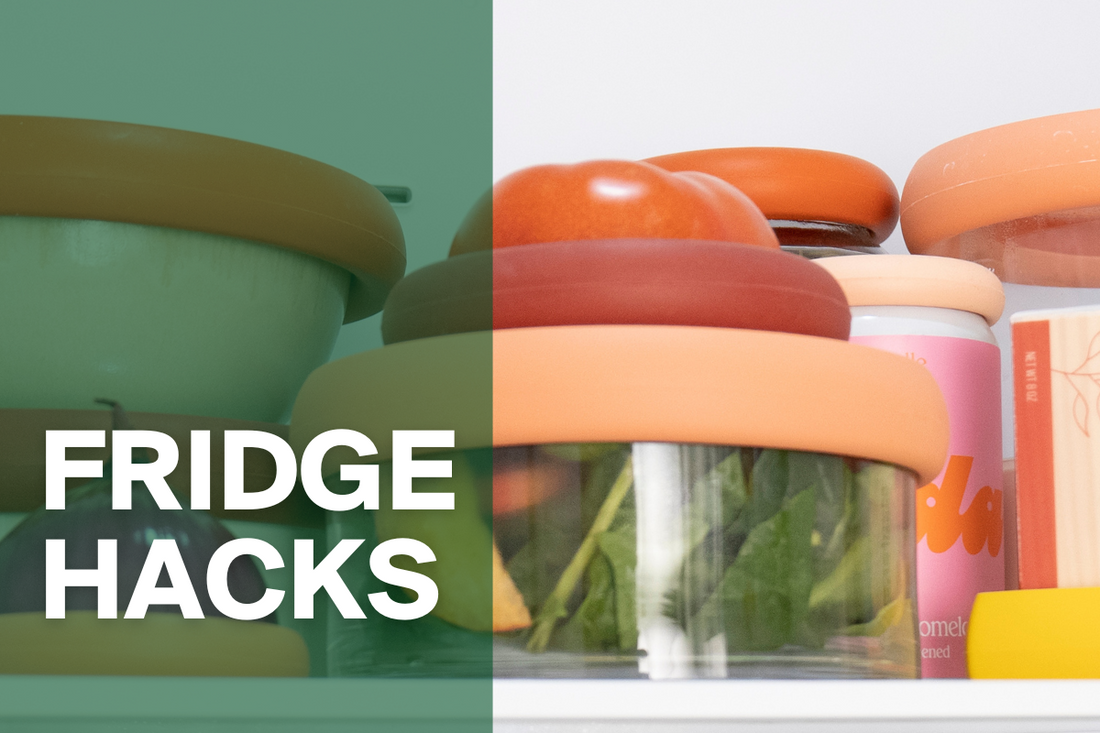Are you tired of finding wilted veggies and moldy leftovers every time you open your refrigerator? As a busy family, it can be challenging to keep your fridge organized and ensure that your food stays fresh for as long as possible.
We’ve got some practical tips and tricks to share that will optimize your fridge storage and minimize food waste. From smart container solutions to creative organization techniques, these hacks are designed to cater to the needs of busy families like yours. Our goal is to help you save time, money, and reduce your environmental impact.
Say goodbye to single-use plastic bags and welcome reusable alternatives. Discover how to maximize the shelf life of your produce and eliminate the need for wasteful packaging. Join the movement towards plastic-free living without compromising on convenience.

The Benefits of Preserving Fresh Food and Embracing Plastic-Free Living
Preserving fresh food and embracing a plastic-free lifestyle offer numerous benefits for both your family and the environment. By optimizing your fridge storage and minimizing food waste, you can save money and reduce your carbon footprint.
When you preserve your fresh food properly, you can enjoy it for longer periods, reducing the need for frequent grocery shopping. This not only saves you time but also helps you cut down on unnecessary expenses.
Embracing a plastic-free lifestyle in your kitchen has a significant impact on the environment. Single-use plastic bags and packaging contribute to pollution and harm marine life. By using reusable alternatives, you are actively reducing plastic waste and promoting a healthier planet.
Meal planning and prepping for busy families

As a busy family, meal planning and prepping can be a game-changer in reducing food waste and ensuring that you always have fresh, healthy meals on hand. By dedicating some time each week to plan and prepare your meals, you can save time, money, and minimize the stress of figuring out what to cook every day.
First, create a weekly meal plan based on your family's preferences and dietary needs. Always consider the ingredients you already have in your fridge and pantry to minimize waste and save money. Bonus points if you can plan meals that can be easily repurposed or transformed into new dishes to make the most of your leftovers. Because life happens and every now and then you’ll have a day of meals you made that you need to reassign somehow. (soups, freezer?) One of our best tips from the home of our cofounder Adrienne is to roast a whole chicken on Sunday and then use the leftovers for sandwiches, salads, or stir-fries throughout the week. One chicken with nearly limitless possibilities.
Once you have your meal plan, make a detailed grocery list of the ingredients you'll need. Stick to the list when you go shopping to avoid impulse purchases and unnecessary waste. Consider shopping at local farmers' markets or joining a community-supported agriculture (CSA) program to support local farmers and reduce the carbon footprint of your groceries. Here’s a useful directory to find a CSA program near you.

After grocery shopping, set aside some time to prep your ingredients. Wash, chop, and portion out your fruits and vegetables so that they're ready to use in recipes or grab as healthy snacks. Cook and portion out grains, beans, and proteins like chicken or tofu, so that they're easily accessible for quick and convenient meals. Invest in mason jars to store your prepped ingredients or use your Food Huggers and Food Huggers Bowl Lids to stack everything up neatly. There is a very special feeling when you look across your prepped ingredients and everything is stacked up and organized. Enjoy it!
By meal planning and prepping, you'll not only save a ton of time during busy weekdays but also massively reduce your food waste. Knowing what ingredients you have and how to use them efficiently ensures that nothing goes to waste. Plus, having prepped ingredients on hand makes it easier to resist the temptation of ordering takeout and stick to your healthy eating goals. When “Sunday You” has sliced the carrots and stored in water, “Thursday You” will be so appreciative for the head start. It’s a time traveling kind of self love and self care.
Fridge Organization Hacks for Better Food Storage
Keeping your fridge organized is a game changing part of preserving fresh food. With a few simple hacks, you can optimize your fridge space in less than 20 min and ensure that everything stays fresh for longer—even with the entire family reaching for leftovers and snacks in the fridge.

-
Use clear containers and labels: Invest in a set of Reusable Stackable Bowl Lids to seal the bowls you already have to store your leftovers, chopped fruits, and veggies. These Bowl Lids not only keep your food fresh but also make it easy to see what you have through the glass top. Labeling them with the date and contents will help you keep track of what needs to be used first. Use any write on wipe off marker on the glass. If you prefer a reusable bag, take a peek at our reusable Hugger Bags. Using a dry erase marker, you can also easily write right on the bag making labeling even easier.
-
Arrange food by expiration date: We call this the “Use it or Lose it” spotlight. When organizing your fridge, place items with the closest expiration dates at the front. You can put an actual placement or use tape to literally highlight that area so everyone in the family knows to “eat this first”. Rearrange your fridge regularly to ensure that older items are not forgotten at the back.
- Utilize fridge drawers effectively: The drawers in your fridge are designed for specific purposes. Use the crisper drawer for storing fruits and vegetables, as it helps maintain their humidity levels. The deli drawer is ideal for storing deli meats and cheeses. By using these drawers as intended, you can extend the freshness of your food.
By implementing these simple organization hacks, you can ensure that your fridge remains clutter-free, and your food stays fresh for longer periods.
Simple DIY fridge deodorizers and cleaners
A clean and fresh-smelling fridge is essential for preserving the quality of your food. However, commercial fridge deodorizers and cleaners often contain harmful chemicals that can contaminate your food. Luckily, there are simple and natural DIY solutions to keep your fridge clean and odor-free.
One easy and effective way to deodorize your fridge is by using baking soda. Simply place an open box or small dish of baking soda on one of the shelves. Baking soda acts as a natural odor absorber, neutralizing any unpleasant smells in your fridge. Remember to replace the box or dish every three months to ensure maximum effectiveness. For an extra boost of freshness, you can add a few drops of essential oil to the baking soda.
To clean your fridge, start by emptying it and removing all the shelves and drawers. Mix equal parts of white vinegar and water in a spray bottle and use this solution to wipe down the interior of the fridge. The acidity of the vinegar helps to remove stains and kill bacteria, leaving your fridge clean and sanitized. For stubborn stains or spills, sprinkle some baking soda on a damp cloth and gently scrub the area. Rinse with water and dry thoroughly before putting the shelves and drawers back in place.

Regularly cleaning and deodorizing your fridge not only keeps your food fresh but also helps maintain its efficiency. A clean fridge ensures proper airflow and temperature distribution, preventing the growth of bacteria and extending the shelf life of your groceries. By utilizing simple DIY solutions, you can keep your fridge in top condition without relying on harsh chemicals.
Tips for Reducing Food Waste and Saving Money
Food waste is a significant issue that not only affects the environment but also drains your wallet. By following these tips, you can reduce food waste and save money at the same time.

-
Plan your meals and make a shopping list: Before heading to the grocery store, plan your meals for the week and make a shopping list. This will help you buy only what you need, reducing the chances of food going to waste.
-
Practice proper food storage: Learn which foods need to be stored in the fridge and which ones are better off at room temperature. For example, potatoes, onions, and tomatoes should be stored in a cool, dark place outside the fridge. We often reference The Ultimate Fresh Produce Storage Guide by Misfit Market to ensure we are properly storing all our delicious produce to maximize shelf life.

-
Utilize your freezer: If you have excess food that you won't be able to consume before it spoils, freeze it for later use. Many fruits and vegetables can be frozen and used in smoothies or cooked dishes. The Taste of Home has an exceptional Guide to Freezing Food.
- Repurpose leftovers: Get creative with your leftovers and transform them into new dishes. Leftover chicken can be used in sandwiches or salads, while vegetable scraps can be turned into nutritious vegetable broth for the entire family. More on this below!
Creative Ways to Repurpose Food Scraps and Reduce waste

One way to repurpose food scraps is by turning them into nutrient-rich compost. Composting not only reduces waste but also provides a valuable resource for your garden or indoor plants. Start by setting up a compost bin in your backyard or even a small composting system on your balcony or kitchen countertop. Collect fruit and vegetable scraps, coffee grounds, eggshells, and yard waste, and let nature do its magic. By composting, you'll be diverting organic waste from landfills and creating a natural fertilizer that can nourish your plants.
Another way to repurpose food scraps is by getting creative in the kitchen. For example, vegetable peels can be turned into flavorful homemade vegetable broth. Simply collect your carrot peels, onion skins, and other vegetable scraps in a bag or container in the freezer. Once you have enough, simmer them in water with some herbs and spices to create a delicious and nutritious broth. This not only reduces waste but also adds a depth of flavor to your soups and stews. Similarly, leftover bread can be transformed into bread crumbs or croutons, while overripe fruits can be used in smoothies, jams, or baked goods. Get creative and experiment with different ways to repurpose food scraps in your kitchen.
By repurposing food scraps, we can minimize waste and make the most of the resources available to us. Not only does this benefit the environment, but it also encourages us to be more mindful of our consumption habits and get creative in the kitchen.
Conclusion: Preserving Your Family’s Fresh Food

Preserving fresh food may seem overwhelming at first, but with these genius fridge hacks, it becomes a manageable and rewarding journey. By finding creative ways to repurpose food scraps, we can make a significant impact on the environment. Simple DIY solutions for cleaning and deodorizing our fridges not only keep our food fresh but also eliminate the need for harmful chemicals. Lastly, meal planning and prepping help busy families save time, money, and reduce food waste.
By implementing these hacks into our daily lives, we can transform our fridges into well-organized, eco-friendly spaces. Let's empower our families to make sustainable choices and enjoy fresh, wholesome food every day. With each small step we take towards a plastic-free lifestyle, we contribute to a healthier planet and a brighter future for our children. So let's open our fridges with excitement, knowing that inside we'll find nourishment, sustainability, and a world of possibilities.
Liked This? Share It on Socials!
At Food Huggers, a woman-owned business and Certified B Corp, we highly value your feedback and engagement.
Reach out to us on Facebook, Instagram, and YouTube. It’s where we share our best sustainability tips, exciting new arrivals and exclusive deals

